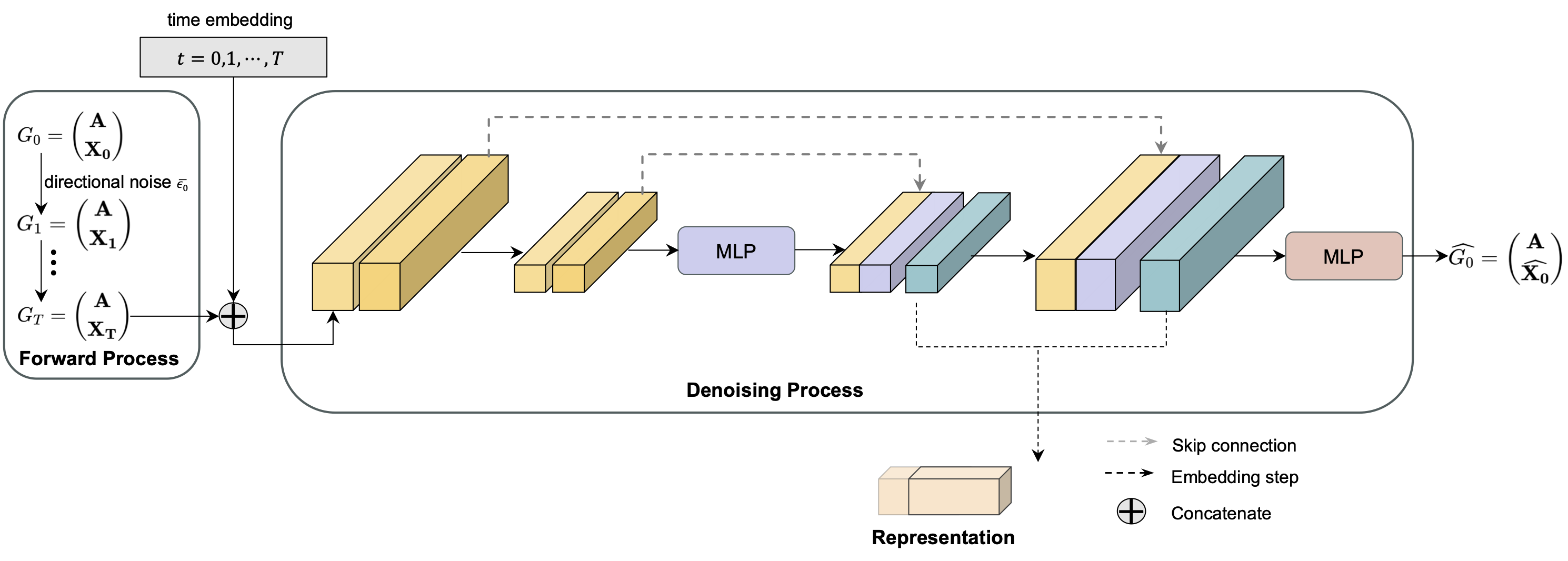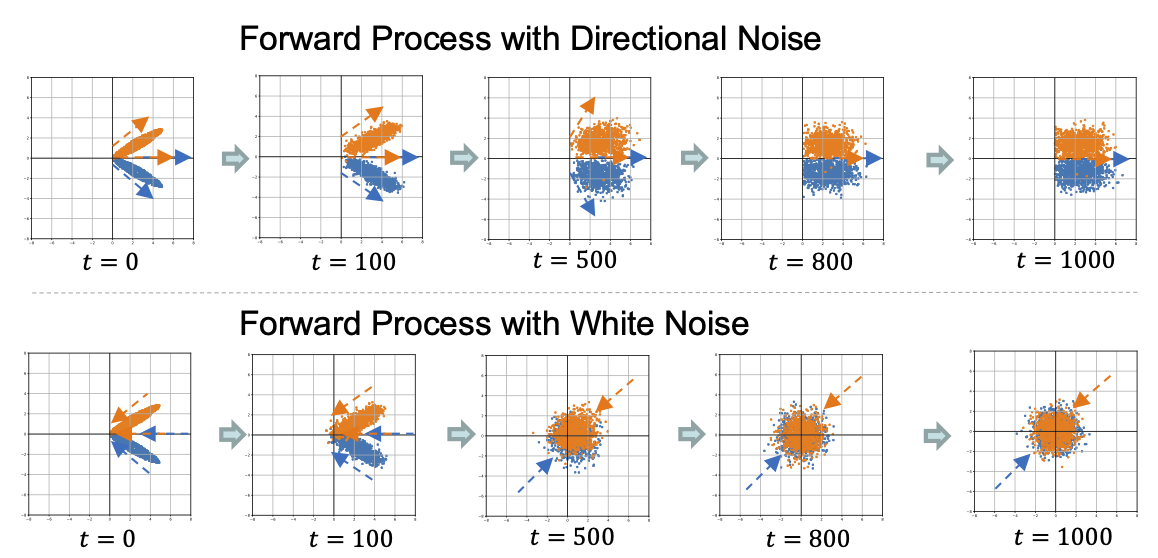Run Yang1, Yuling Yang1, Fan Zhou1, Qiang Sun2
1Shanghai University of Finance and Economics, 2University of Toronto
We introduce a novel class of models termed directional diffusion models (DDM), which adopt data-dependent, anisotropic, and directional noises in the forward diffusion process. This code is an implementation of DDM on 12 public graph datasets.
- IMDB-B
- IMDB-M
- COLLAB
- REDDIT-B
- PROTEINS
- MUTAG
- CORA
- Citeseer
- PubMed
- Ogbn-arxiv
- Amazon-Computer
- Amazon-Photo
conda create -n ddm python=3.8
conda activate ddm
cd ddm-nni
pip install -r requirements.txtcd to EXP path(MUTAG for example)
cd GraphExp
python main_graph.py --yaml_dir ./yamls/MUTAG.yamlIn view of the sensitivity of diffusion method to hyperparameters, it is recommended to use hyperparameter search methods like NNI to achieve better results Trust me ! In this way, you can achieve better results than what is presented in the paper
| IMDB-B | IMDB-M | COLLAB | REDDIT-B | PROTEINS | MUTAG | |
|---|---|---|---|---|---|---|
| GIN[1] | 75.1±5.1 | 52.3±2.8 | 80.2±1.9 | 92.4±2.5 | 76.2±2.8 | 89.4±5.6 |
| DiffPool[2] | 72.6±3.9 | - | 78.9±2.3 | 92.1±2.6 | 75.1±2.3 | 85.0±10.3 |
| Infograph[3] | 73.03±0.87 | 49.69±0.53 | 70.65±1.13 | 82.50±1.42 | 74.44±0.31 | 89.01±1.13 |
| GraphCL[4] | 71.14±0.44 | 48.58±0.67 | 71.36±1.15 | 89.53±0.84 | 74.39±0.45 | 86.80±1.34 |
| JOAO[5] | 70.21±3.08 | 49.20±0.77 | 69.50±0.36 | 85.29±1.35 | 74.55±0.41 | 87.35±1.02 |
| GCC[6] | 72 | 49.4 | 78.9 | 89.8 | - | - |
| MVGRL[7] | 74.20±0.70 | 51.20±0.50 | - | 84.50±0.60 | - | 89.70±1.10 |
| GraphMAE[8] | 75.52±0.66 | 51.63±0.52 | 80.32±0.46 | 88.01±0.19 | 75.30±0.39 | 88.19±1.26 |
| DDM | 76.40±0.22 | 52.53±0.31 | 81.72±0.31 | 89.15±1.3 | 75.74±0.50 | 91.51±1.45 |
| Dataset | Cora | Citeseer | PubMed | Ogbn-arxiv | Computer | Photo |
|---|---|---|---|---|---|---|
| GAT | 83.0 ± 0.7 | 72.5 ± 0.7 | 79.0 ± 0.3 | 72.10 ± 0.13 | 86.93 ± 0.29 | 92.56 ± 0.35 |
| DGI[9] | 82.3 ± 0.6 | 71.8 ± 0.7 | 76.8 ± 0.6 | 70.34 ± 0.16 | 83.95 ± 0.47 | 91.61 ± 0.22 |
| MVGRL[7] | 83.5 ± 0.4 | 73.3 ± 0.5 | 80.1 ± 0.7 | - | 87.52 ± 0.11 | 91.74 ± 0.07 |
| BGRL[10] | 82.7 ± 0.6 | 71.1 ± 0.8 | 79.6 ± 0.5 | 71.64 ± 0.12 | 89.68 ± 0.31 | 92.87 ± 0.27 |
| InfoGCL[11] | 83.5 ± 0.3 | 73.5 ± 0.4 | 79.1 ± 0.2 | - | - | - |
| CCA-SSG[12] | 84.0 ± 0.4 | 73.1 ± 0.3 | 81.0 ± 0.4 | 71.24 ± 0.20 | 88.74 ± 0.28 | 93.14 ± 0.14 |
| GPT-GNN[13] | 80.1 ± 1.0 | 68.4 ± 1.6 | 76.3 ± 0.8 | - | - | - |
| GraphMAE[8] | 84.2 ± 0.4 | 73.4 ± 0.4 | 81.1 ± 0.4 | 71.75 ± 0.17 | 88.63 ± 0.17 | 93.63 ± 0.22 |
| DDM | 83.4±0.2 | 74.3±0.3 | 81.7±0.8 | 71.29±0.18 | 90.56±0.21 | 95.09±0.18 |
[1]:Xu, K., Hu, W., Leskovec, J., and Jegelka, S. (2018). How powerful are graph neural networks?
arXiv preprint arXiv:1810.00826.
[2]:Ying, Z., You, J., Morris, C., Ren, X., Hamilton, W., and Leskovec, J. (2018). Hierarchical graph
representation learning with differentiable pooling. Advances in neural information processing
systems, 31.
[3]:Sun, F.-Y., Hoffmann, J., Verma, V., and Tang, J. (2019). Infograph: Unsupervised and semi-
supervised graph-level representation learning via mutual information maximization. arXiv preprint
arXiv:1908.01000.
[4]:You, Y., Chen, T., Sui, Y., Chen, T., Wang, Z., and Shen, Y. (2020). Graph contrastive learning with
augmentations. Advances in neural information processing systems, 33:5812–5823.
[5]:You, Y., Chen, T., Shen, Y., and Wang, Z. (2021). Graph contrastive learning automated. In
International Conference on Machine Learning, pages 12121–12132. PMLR.
[6]:Qiu, J., Chen, Q., Dong, Y., Zhang, J., Yang, H., Ding, M., Wang, K., and Tang, J. (2020). Gcc:
Graph contrastive coding for graph neural network pre-training. In Proceedings of the 26th ACM
SIGKDD international conference on knowledge discovery & data mining, pages 1150–1160.
[7]:Hassani, K. and Khasahmadi, A. H. (2020). Contrastive multi-view representation learning on graphs.
In International conference on machine learning, pages 4116–4126. PMLR.
[8]:Hou, Z., Liu, X., Dong, Y., Wang, C., Tang, J., et al. (2022). Graphmae: Self-supervised masked
graph autoencoders. arXiv preprint arXiv:2205.10803.
[9]:Velickovic, P., Fedus, W., Hamilton, W. L., Liò, P., Bengio, Y., and Hjelm, R. D. (2019). Deep graph
infomax. ICLR (Poster), 2(3):4.
[10]:Thakoor, S., Tallec, C., Azar, M. G., Azabou, M., Dyer, E. L., Munos, R., Veliˇckovi ́c, P., and
Valko, M. (2021). Large-scale representation learning on graphs via bootstrapping. arXiv preprint
arXiv:2102.06514.
[11]:Xu, D., Cheng, W., Luo, D., Chen, H., and Zhang, X. (2021). Infogcl: Information-aware graph
contrastive learning. Advances in Neural Information Processing Systems, 34:30414–30425.
[12]:Zhang, H., Wu, Q., Yan, J., Wipf, D., and Yu, P. S. (2021). From canonical correlation analysis
to self-supervised graph neural networks. Advances in Neural Information Processing Systems,
34:76–89.
[13]:Hu, Z., Dong, Y., Wang, K., Chang, K.-W., and Sun, Y. (2020b). Gpt-gnn: Generative pre-training of
graph neural networks. In Proceedings of the 26th ACM SIGKDD International Conference on
Knowledge Discovery & Data Mining, pages 1857–1867.

